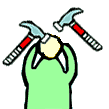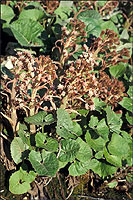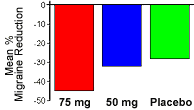 February 7, 2005
February 7, 2005
MIGRAINE: It starts when you see
spots or lines that aren't really there.
This is followed by a headache, usually on one side of the head only.
Lights, noises and moving around make the headache worse. The headache
may last a few hours or even for a few days.
Scientists believe that migraines are caused by an abnormality in the
brain's blood supply. Some people find relief from migraine with
over-the-counter pain medicines or antiseizure and antidepressant drugs.
Even botox has been used against headache pain.
Researchers have recently turned their attention to a plant called butterbur (Petasites hybridus) for a possible
herbal treatment for migraine.
 Although butterbur has been used in herbal medicines for
centuries, well-designed experiments about the effectiveness of this plant
to treat migraine had not been conducted. Although butterbur has been used in herbal medicines for
centuries, well-designed experiments about the effectiveness of this plant
to treat migraine had not been conducted.
Petasites hybridus (Butterbur)

 2004 Dr. Amadej
Trnkoczy. 2004 Dr. Amadej
Trnkoczy. |
Therefore, Dr. Richard Lipton led a team of American and German
researchers to investigate the effects of butterbur on migraine.
A total of 202 people who suffered from migraine were divided into three
groups:
- Group 1 (68 subjects): received capsules containing 75-milligrams of
a butterbur extract.
- Group 2 (71 subjects): received capsules containing 50-milligrams of
a butterbur extract.
- Group 3 (63 subjects): received placebo capsules without any
butterbur extract.
 This experiment was "double-blinded" because both the researchers and the
subjects did not know which group each subject was in. Also, the effects
of butterbur were compared to a placebo. A placebo is a drug or treatment
that has no active ingredient. It is important to have some subjects in
an experiment receive a placebo treatment because this allows researchers
to separate the "real" effects of a drug or treatment from the effects of
merely being in the experiment. Also, some illnesses will cure themselves.
For example, the common cold will get better in about 7-10 days without
any treatment.
This experiment was "double-blinded" because both the researchers and the
subjects did not know which group each subject was in. Also, the effects
of butterbur were compared to a placebo. A placebo is a drug or treatment
that has no active ingredient. It is important to have some subjects in
an experiment receive a placebo treatment because this allows researchers
to separate the "real" effects of a drug or treatment from the effects of
merely being in the experiment. Also, some illnesses will cure themselves.
For example, the common cold will get better in about 7-10 days without
any treatment.
 The number of migraine attacks during a 4-month treatment period was
recorded for each subject and compared to the number of attacks the
subjects suffered before treatment. Those people who received
75-milligrams of butterbur extract had an average of 45% fewer migraine
attacks per month. The 50-milligram butterbur dose resulted in 32% fewer
migraine attacks per month. People who received the placebo had 28% fewer
migraines. The only significant side effect of butterbur was more
frequent burping.
The number of migraine attacks during a 4-month treatment period was
recorded for each subject and compared to the number of attacks the
subjects suffered before treatment. Those people who received
75-milligrams of butterbur extract had an average of 45% fewer migraine
attacks per month. The 50-milligram butterbur dose resulted in 32% fewer
migraine attacks per month. People who received the placebo had 28% fewer
migraines. The only significant side effect of butterbur was more
frequent burping.
Dr. Lipton and his co-workers suggest two ways that butterbur may reduce
migraines:
- Butterbur may decrease inflammation of
blood vessels and other tissues that cause pain.
- Calcium channels on neurons help regulate the release of
neurotransmitters in the brain. Some migraines may be caused by
abnormalities in calcium channels. Butterbur may work on calcium
channels to alter abnormal neurotransmitter release.
CAUTION!
 |
You may have butterbur growing in your garden. However, raw butterbur
root is TOXIC! The dangerous chemicals in the butterbur plant were
removed from the extracts used in the migraine
experiment. |
| 
 February 7, 2005
February 7, 2005![[email]](./gif/menue.gif)




 2004 Dr. Amadej
Trnkoczy.
2004 Dr. Amadej
Trnkoczy. This experiment was "double-blinded" because both the researchers and the
subjects did not know which group each subject was in. Also, the effects
of butterbur were compared to a placebo. A placebo is a drug or treatment
that has no active ingredient. It is important to have some subjects in
an experiment receive a placebo treatment because this allows researchers
to separate the "real" effects of a drug or treatment from the effects of
merely being in the experiment. Also, some illnesses will cure themselves.
For example, the common cold will get better in about 7-10 days without
any treatment.
This experiment was "double-blinded" because both the researchers and the
subjects did not know which group each subject was in. Also, the effects
of butterbur were compared to a placebo. A placebo is a drug or treatment
that has no active ingredient. It is important to have some subjects in
an experiment receive a placebo treatment because this allows researchers
to separate the "real" effects of a drug or treatment from the effects of
merely being in the experiment. Also, some illnesses will cure themselves.
For example, the common cold will get better in about 7-10 days without
any treatment.  The number of migraine attacks during a 4-month treatment period was
recorded for each subject and compared to the number of attacks the
subjects suffered before treatment. Those people who received
75-milligrams of butterbur extract had an average of 45% fewer migraine
attacks per month. The 50-milligram butterbur dose resulted in 32% fewer
migraine attacks per month. People who received the placebo had 28% fewer
migraines. The only significant side effect of butterbur was more
frequent burping.
The number of migraine attacks during a 4-month treatment period was
recorded for each subject and compared to the number of attacks the
subjects suffered before treatment. Those people who received
75-milligrams of butterbur extract had an average of 45% fewer migraine
attacks per month. The 50-milligram butterbur dose resulted in 32% fewer
migraine attacks per month. People who received the placebo had 28% fewer
migraines. The only significant side effect of butterbur was more
frequent burping. 